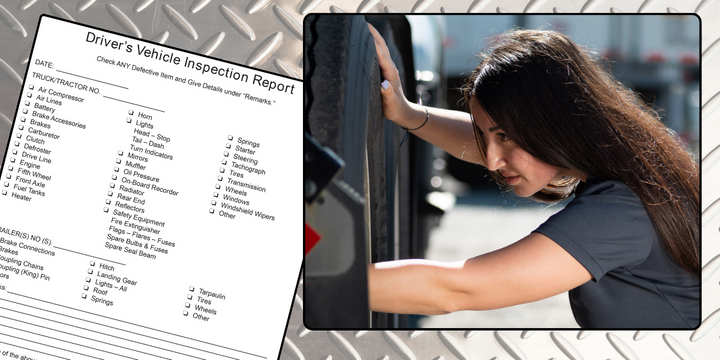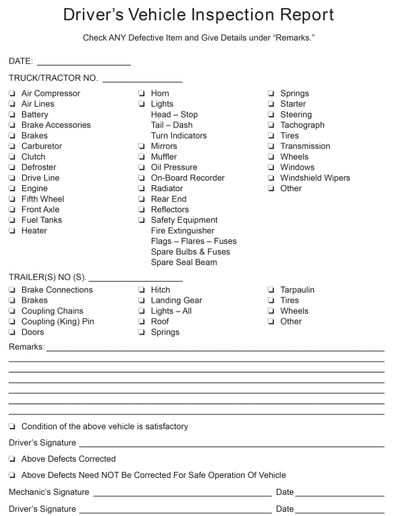Trucker Access › Forums › Diesel News › When Must Truckers Complete a Driver Vehicle Inspection Report? – Safety & Compliance
- This topic has 0 replies, 1 voice, and was last updated 11 months, 1 week ago by
 EazyRiDer66.
EazyRiDer66.
-
AuthorPosts
-
May 15, 2024 at 6:30 am #20556
 EazyRiDer66Keymaster
EazyRiDer66Keymaster

There’s a misconception about when drivers need to turn in DVIRs.
A common misconception about driver vehicle inspection reports for truckers and other commercial drivers is that one is required at every pre-trip inspection.
- How often must a walk-around pre-trip inspection be conducted? Before every trip.
- How often is a post-trip inspection required to be performed? After every trip.
When Does a Driver Have to Turn in a DVIR?
“There’s a lot of confusion in the industry,” says Tom Bray, a business advisor with J.J. Keller. “The driver needs to do a pre-trip — they have to be satisfied the vehicle’s in good operating condition before they drive it. That’s the bottom line. There’s no report required.
“If there’s something wrong with the vehicle, the driver needs to get in touch with you and say, hey, this needs to be fixed before I can drive it.”
If a driver discovers a safety-related defect during the pre-trip inspection, while there may not be a federal requirement to file a DVIR, Bray says, you still need a process in place for how the driver reports it. If he’s in the yard, does he head to the maintenance shop? If drivers are on the road when they find something, do they know who to call or message to work with to get that fixed?
Post-Trip Inspections and DVIRs

A sample driver vehicle inspection report from FMCSA.
It’s at the end of the day, during the post-trip inspection, that finding a defect triggers the legal requirement from the Federal Motor Carrier Safety Administration to file a DVIR.
“At the end of the day, the driver does a post-trip, which can be as simple as a quick walk around,” Bray says. “But at that point, that’s where the driver needs to submit a report to the company saying, ‘I have this defect on the vehicle.’ That’s what’s required in the regulations. If there’s a defect on the vehicle, the company has to be notified, the driver has to complete a DVIR and submit it.
Some companies choose to have the driver submit a daily DVIR, defects or not, and that’s allowed in the regulations — it’s just not required by the FMCSA.
The Importance of the Post-Trip Inspection
“Everybody talks about the pre-trip,” says Michael Dominguez, VP of business operations, procurement and fleet management for Transervice Logistics.
But, he says, the post-trip inspection is actually more important.
“If I do a post-trip inspection flawlessly, and I catch everything, and I have a maintenance shop or provider that now can have from 5:00 in the afternoon to 7:00 in the morning to repair it, the chances of me running a real tight ship is greater because now I’ve got extra time for the maintenance to get done.
“We like to shift the emphasis to the post-trip, because the pre-trip is then automatic. I’ve already done my post-trip, I’ve done all the repairs, my pre-trip is a whiz, I’m just making sure that everything is signed off on.”
He says he learned this from one of the first DOT officers he had come in to help train drivers.
“If we put a tremendous amount of effort on the post-trip when it’s back at the yard, when I have a technician that can take the next two hours fixing it, It changes the results tremendously.
“So everybody talks about the pre-trip. They know there’s a post trip, but the emphasis really needs to be reversed. The post-trip needs to be the best.”
DVIRs and Lighter-Duty Commercial Vehicles
Another point of confusion about driver vehicle inspections and DVIRs, Bray says, is in lighter vehicles.
“The requirement applies to anything 10,001 pounds or more that you’re using in interstate commerce. And there’s a lot of people in that 10,001 to 26,000 pound category who don’t think it applies to them, because their drivers don’t have to have a CDL. So they don’t have to know how to do inspections, because they’re not taking a test on it.”
-
AuthorPosts
- You must be logged in to reply to this topic.